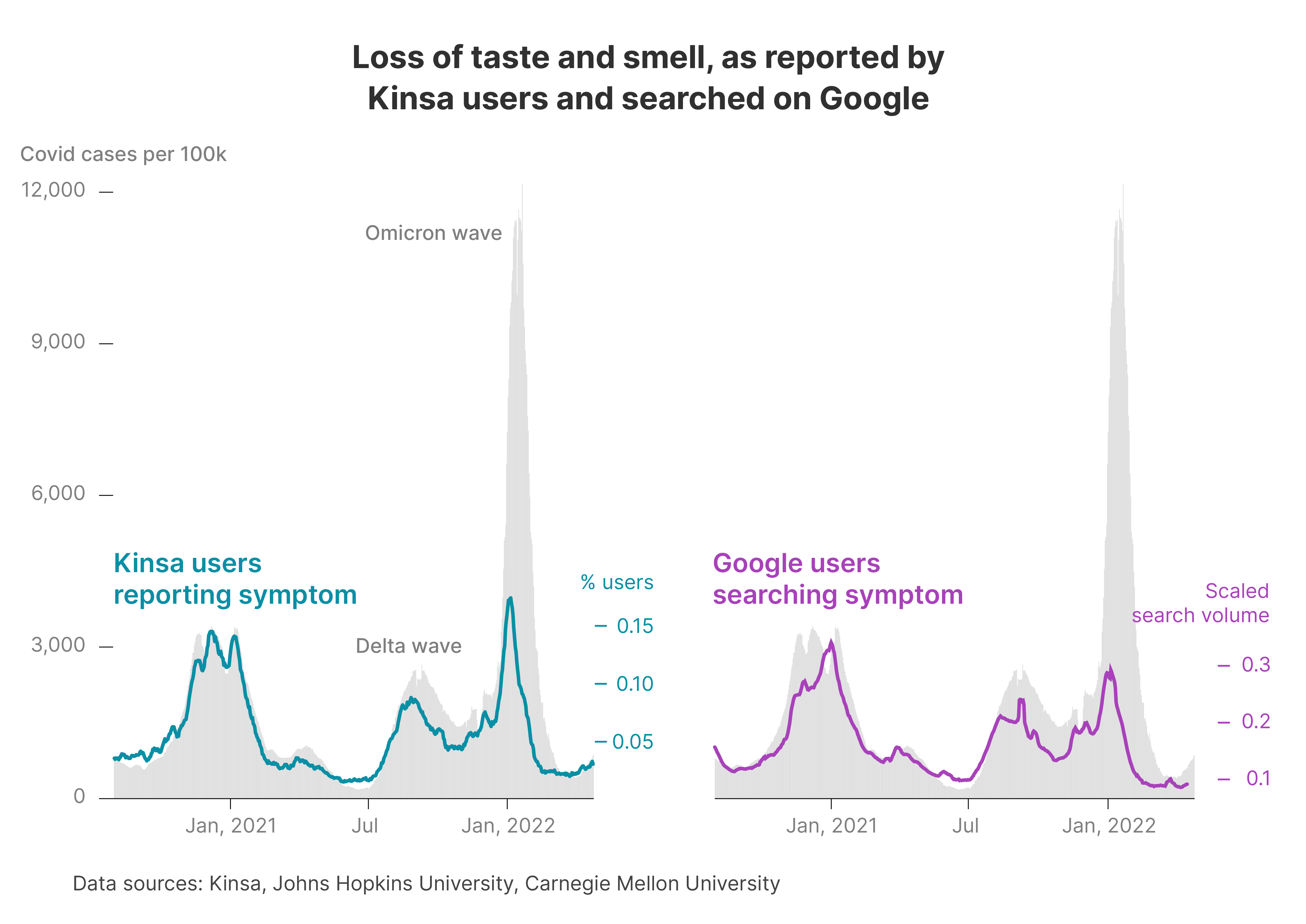
By this point, we know that COVID-19 can cause almost any symptom under the sun, from cough to fatigue to stomachache. Since COVID-19 symptoms often appear similar to those of the common cold, flu, and other contagious illnesses, a test is necessary to confirm diagnosis. However, there is one symptom that is fairly unique to COVID: the loss of taste or smell.
The frequency of Kinsa users reporting losing their sense of taste or smell tracks COVID-19 case trends very closely. We can also monitor the symptom using Google searches for “loss of taste or smell.” While both Kinsa and Google data sources follow similar trends, Kinsa’s aggregated and anonymized symptom reporting catches the dramatic rise of cases during the Omicron wave more closely than Google searches do.

Our data supports a recent study that found the loss of taste or smell occurred less often in people infected during the Omicron wave compared to earlier waves. Still, over 30% of study participants infected with Omicron experienced the loss of at least one of these senses, compared to 67% of participants in earlier waves.
Who loses their sense of taste or smell?
Among all symptoms for any illness recorded in the Kinsa app since June 2020, loss of taste and smell was relatively rare, with 5% of users reporting it overall. The prevalence of this unique symptom varied by age group, with users over age 18 four times more likely to report it than those aged 2-18. Among adults, the 18-40 age group seemingly was the sweet spot to experience this unusual symptom – those users were 24% more likely to report the symptom than those over age 40. Similarly, a meta-analysis of 210 studies found that the symptom was seen most often in adults in their late 30’s.
If you can’t taste or smell, what other symptoms might you expect to feel?
Among Kinsa’s adult users who lost the ability to taste or smell, about 60% also experienced body aches and 61% reported a cough.
But, what if a child in your family is the one who can no longer taste or smell? The good news is that kids, even if they lose their taste or smell, are less likely to experience severe COVID-19 symptoms compared to adults. Among Kinsa users aged 2-18 years who lose their sense of taste or smell, only 35% experienced body aches and 57% reported a cough. Though concurrent symptoms were less common among children, a study found that their loss of smell became more prevalent after the first few days of symptoms.
So what can I do to make sure I can smell those spring blooms?
Get vaccinated and boosted if you have not yet! Preventing COVID-19 is the best way to avoid this symptom, and getting vaccinated and boosted significantly lowers your risk of catching COVID-19.
Unfortunately, losing smell and taste is still relatively common among vaccinated folks experiencing breakthrough cases, with about 62% experiencing the symptom. For those who’ve experienced loss of taste or smell, smell training is one technique used to help expedite recovery. Thankfully, long-term changes in smell seem to be rare with about 90% of people fully recovering their sense of smell within six weeks of initially reporting the loss.
To learn more about the data behind this article and what Kinsa has to offer, visit https://www.kinsahealth.co/.







Sign up to receive our stories in your inbox.
Data is changing the speed of business. Investors, Corporations, and Governments are buying new, differentiated data to gain visibility make better decisions. Don't fall behind. Let us help.













Sign up to receive our stories in your inbox.
Data is changing the speed of business. Investors, Corporations, and Governments are buying new, differentiated data to gain visibility make better decisions. Don't fall behind. Let us help.





